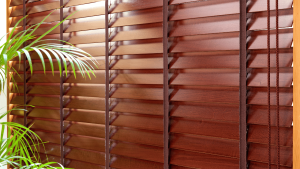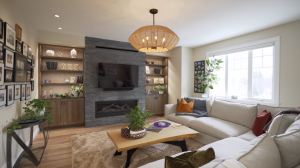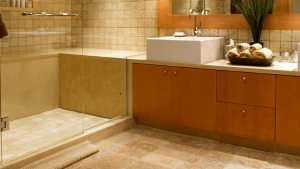Can You Paint Hardwood Floors? Painting Hardwood Floors is a great way to give old floors a fresh, updated look without the cost of refinishing or replacing them. Even painting wood floors has a long tradition throughout this country and beyond. The biggest reason for painting wood floors is to extend their life. It is both less work and inexpensive than replacing a floor. Painting floors can also help hide imperfections, but there are a few crucial steps and considerations to follow, and It also requires some materials and tools.
Materials & Tools
Materials :

- Wood Cleaner: A mixture of water and vinegar is the best cleaner for the floor.
- Sandpaper: Requires Fine-grit sandpaper for sanding the floor
- Wood Filler: Requires Color matched paintable wood filler, for repairing cracks, gaps, or imperfections in the wood floor.
- Primer: A bonding primer that can adhere to a previously finished surface. Oil-based or latex primers are specifically used for wood floors.
- Paint: Porch and floor paint or interior latex paint if you’re looking for durability. Specialty floor paint if you want enhanced durability and slip resistance.
- Polyurethane: You can use Water-based polyurethane for faster drying and less odor or oil-based polyurethane for higher durability. However, it takes longer to dry and can turn yellow with time.
Tools:

- Broom or Vacuum: Required to clean the floor before and after sanding.
- Orbital Sander and Hand Sander: An orbital sander speeds up the sanding process and provides a better result for large areas. Hand sanders are useful for edges and corners that a large sander can’t reach.
- Blade or Knife: it is used for wood filler and smoothness, smoothing into cracks and imperfections.
- Painter’s Tape: Protects baseboards and creates clean lines along the walls and if you want a design, Its useful for creating patterns.
- Paint brush and roller: A high-quality roller for evenly applying primer, paint, and polyurethane. A brush for edging and cutting in along baseboards and around obstacles. Synthetic bristle brushes for applying water-based paint and polyurethane, and natural bristle brushes for oil-based products.
- Paint Trays: Used for holding and applying paint, primer, and polyurethane.
- Rags or Tack Clothes: Used for cleaning up dust and spills, Tack cloths are particularly useful to pick up fine dust.
As per above materials and tools, you’ll be able to paint your hardwood floors efficiently and achieve a durable, professional-looking finish.
If you’re looking to install hardwood flooring in your home then contact LCF Flooring
How to Paint Hardwood Floors:
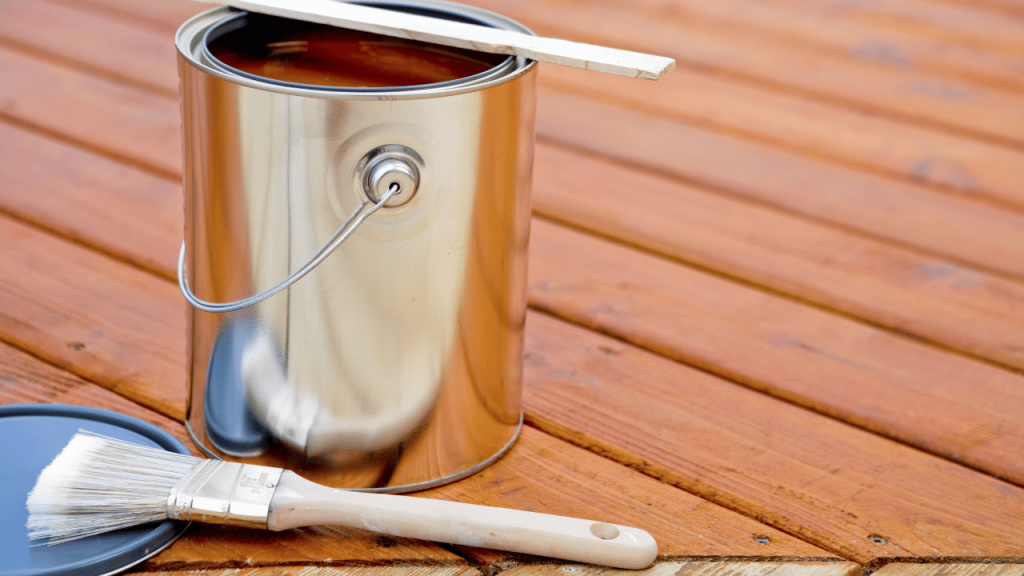
Here, we will discuss in detail about how to paint hardwood floors. Before starting, it’s important to gather all the materials and tools you’ll need as in detail you have read above.
Clean, Repair and Sanding the Floor:
Use Sweep or vacuum the floor to remove dirt and dust. Use a wood cleaner thoroughly to clean the surface. This will remove any oils, grime, that could prevent the paint from sticking and let the floor dry completely. Sanding is essential for giving the paint a surface to adhere to, using fine-grit sandpaper (150-220 grit), lightly sand the entire floor. If the floorboards have cracks or gaps, fill them with wood filler. Once the filler is dry, sand the repaired areas until smooth. After that use vacuum to remove dust, and follow up with a tack cloth or microfiber cloth and wipe the floor clean.
Apply Primer to the Floor:
Applying primer is necessary before painting on a hardwood floor for the paint to stick properly. First we have to choose the right primer, an oil primer or a high quality bonding primer works best, it provides a long life to paint. Now apply the primer and use a roller to coat the primer over the entire floor. A brush can be used to cut in around edges and tight spaces. Let the primer dry completely as per instructions. This could take anywhere from a few hours to a full day.
Paint the Floor:
Choose the Right Paint Whether you choose a neutral tone or a bold color. Opt for porch and floor paint or interior latex paint that’s made to withstand foot traffic and wear. Specialty floor paints are another great option, especially if you want extra durability.
Now apply the the first coat, start by cutting in around the edges of the room with a brush, and then use a roller for the larger sections. Apply the paint in thin, even coats, working with the grain of the wood. After that let the first coat dry for 4-24 hours, depending on the type of paint and environmental conditions. Now apply additional coats for the best coverage, plan on applying 2-3 coats of paint. Let each coat dry completely before applying the next one.
Protect with Polyurethane:
If you want to protect your freshly painted floors and ensure they hold up to everyday wear and tear, you will need to apply a clear coat of polyurethane. Polyurethane comes in both water-based and oil-based varieties. Water-based polyurethane dries faster and has a clearer finish, while oil-based polyurethane offers better durability but can turn yellow over time. Choose between satin, semi-gloss, or gloss finish depending on how much shine you want. Apply the Polyurethane to the floor with a foam roller or brush, apply a thin, even coat of polyurethane to the painted surface, wait for the first coat dry completely, then lightly sand the surface with fine-grit sandpaper to ensure the second coat adheres well. Apply 2-3 coats, allowing each coat to dry fully before applying the next.
Allow It to Dry Completely and Enjoy:
After the final coat of polyurethane, it’s necessary to let the floor dry and cure before placing furniture or walking on it with shoes. Usually curing Time will be 24-48 hours, it’s best for you to wait at least one week before moving heavy furniture back into the room, and for extra protection, place felt pads on the bottom of furniture legs to prevent scratches.
Learn How Long Does It Take to Install Hardwood Floors?
How to Get Paint Off Hardwood Floor?
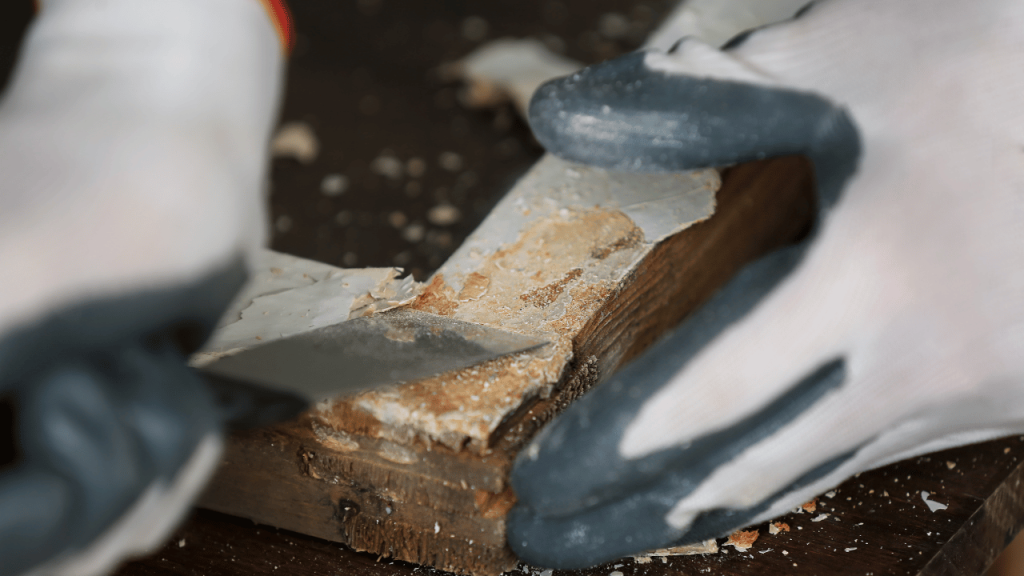
If you have accidentally spilled paint on your hardwood floor, it is possible to remove paint from hardwood surfaces without damaging the wood if you use the right method.
First you assess the paint type, understanding the type of paint will help you choose the right removal technique. Water-based paint (like latex) is easier to remove than oil-based paint. Now gather your tools, for dried paint, you’ll need a plastic scraper, damp cloth, and gentle solvents (like rubbing alcohol or vinegar). For stubborn stains, a commercial paint remover designed for wood may be necessary.
- Now start by softening the paint with a damp cloth soaked in warm water (for water-based paint) or rubbing alcohol (for oil-based paint).
- Use a plastic scraper to gently lift the softened paint, being careful not to scratch the wood. After that use a Solvent (if needed):
- For tougher spots, apply a wood-safe paint remover or rubbing alcohol using a cloth. Let it sit for a few minutes before gently scrubbing the paint away.
- If the paint is deeply embedded, lightly sand the area with fine-grit sandpaper. Be cautious to avoid damaging the floor’s finish.
- Once the paint is removed, clean the area with a wood-safe cleaner and, if necessary, apply a wood polish to restore the floor’s shine.
By following these steps, you can safely remove paint from hardwood floors and keep your wood looking beautiful!
How to Get Old Paint Off Hardwood Floor?

If you want to remove old paint from hardwood floors, the process will be lengthy but can still be done effectively with the right tools and methods.
Use of a Paint Stripper:
Use paint stripper which is specifically formulated for wood, apply a small amount on a discreet area of the floor to ensure it won’t damage the wood. Let it sit for the time recommended on the product label. Apply the paint stripper across the floor using a brush or roller, ensuring full coverage on the painted areas. Follow the manufacturer’s instructions for how long to leave the stripper on the paint, usually around 15-30 minutes.
Scrape Off the Paint:
After using the Paint Stripper, wait for it to soften and use a scraper to gently lift the old paint off the floor. Start with a plastic scraper to avoid gouging the wood, but if necessary, switch to a metal scraper for tougher areas, and if you see any stubborn spots, use steel wool or an abrasive pad dipped in mineral spirits, but avoid excessive scrubbing that could scratch the wood. If the paint is particularly old or thick, or if the stripper didn’t remove it all, lightly sand the entire area with an orbital sander and fine-grit sandpaper
Clean and Refinish the Floor:
In the final steps, wipe down the floor with a clean rag and a mixture of water and vinegar, or use a wood-safe cleaner, to remove dust and residue from the paint stripper and sanding. Once the old paint is gone and the floor is clean, apply a finish like polyurethane or wood stain to protect the wood and restore its natural beauty.
Precautions:
Use proper ventilation after using paint strippers and solvents. They can emit strong fumes, so make sure the area is well-ventilated. Use painter’s tape and plastic sheets to protect baseboards and nearby surfaces.
By following these steps, you can safely remove old paint and restore your hardwood floors to their original condition, ready for refinishing or a fresh new look.
Final Thoughts
Hardwood floors always offer natural beauty and durability for any home. It is necessary to know how to properly care for your hardwood floors. Painting hardwood floors can give your home a stylish, personalized touch, and with the right tools and techniques, you can achieve a long-lasting result. And if you want to try to get paint off hardwood floors, whether it’s a recent spill or old layers of paint, there are effective methods to restore the natural beauty of your wood without causing damage. From painting your floors to removing unwanted paint, these tasks can be handled efficiently, keeping your hardwood looking great for years to come.


